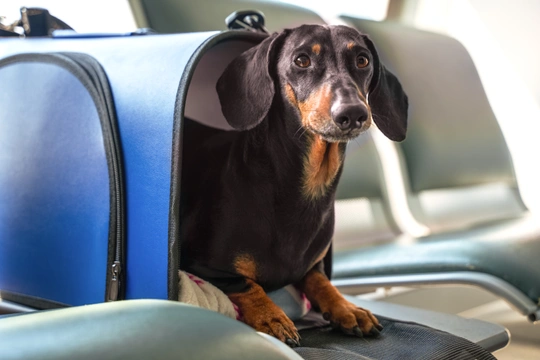
Travel with your dog: by car, plane or public transport
The ideal time to get your dog used to as many types of transport as possible is when they’re very young. For many of you, trips are most likely to be by car or on public transport. Some of you may be planning to take your dog on planes.
With your own car, you benefit from control over when, how and where you can practice. Of course, that’s unlikely to be the same with all modes of transport. You can get your dog slowly accustomed to your car, but the first time they go on a plane is likely to be when it’s about to take off. So, for other forms of transport, the best you can do in advance is get them used to being restrained in the type of carrier or harness that will be needed for the journey and, where possible, the sights, sounds and smells they’ll meet.
Car travel with your dog
Let’s start with the car. Make sure you have a secure, safe space in the vehicle for your puppy or older dog. You could use a special dog harness that clips to the seatbelt, a carrier or a purpose-built crate fitted into the back of a van, hatchback or estate car.
Be prepared for the time it may take to get your puppy used to travelling in the car. Some may be quite happy immediately, others more wary. It’s worth spending time ensuring they find your car an enjoyable place to be. If your dog seems anxious, maybe whining or barking or trying to get out of the carrier or harness, start by simply getting them comfortable being in a stationary car – just hanging out with some nice, tasty treats or a chew, or even feed them their meals in the car for a few days. Then you can graduate to switching the engine on and, if all is calm, go for a few short drives.
If your dog is old enough and able to get in and out of the car without being lifted, make sure to teach them to wait for a cue from you before jumping out. You don’t want to risk an excited dog leaping out of the car as soon as you open the door.
Putting in the effort at the start will help set your dog up for a lifetime of enjoyable car journeys with you.
Flying with your dog
Unless you happen to own your own aeroplane, you won’t be able to introduce your dog to it slowly. You can, though, take the time to get them used to the type of carrier they’ll need to travel in on an aeroplane. Find out well in advance from the airline what sort of carrier is allowed, and get your dog accustomed to spending time in it. Again, treats and chews will help them begin to associate being in it with good things. If it’s not too heavy, do get your dog used to being carried in it. Move it to different places around the house or garden or even in the car. When it’s time for the actual plane trip, although a lot of the other sights, sounds and smells will be very unfamiliar to your dog, at least the carrier will feel like a safe space to be.
Public Transport
Whether you have a car or not, many of you are likely to want to take your dog along on journeys that involve buses or trains (underground or overground). In fact, if you don’t have a car, it’s a great way to give your dog new experiences, perhaps by taking them to different places for walks.
Do check that the mode of transport you’re considering accepts dogs. This can vary.
Where you can, follow the suggestions above for taking your time to get your dog used to a new mode of travel – perhaps a visit to a train station just to watch the trains from a safe distance, or a few short bus rides to start with.
Ideally, plan a time when it’s not likely to be too busy. Rush hour is not the time to introduce a dog to buses or underground trains!
Be aware that dogs need to be carried on underground escalators, so if your dog is a Great Dane or other large breed and simply too heavy to carry, do check you’ve chosen a route with stairs!
What to take when travelling with your dog
If you’re going to be out for some time, especially if it’s hot, make sure you have water and something for your dog to drink it from. There are plenty of travel bowls and other gadgets that allow the water to drip into a bowl-shaped receptacle. Obviously, if it’s a much longer trip, as well as maybe some treats to reward your dog for settling calmly on the journey, you may need to bring their meal with you as well.
Most dogs, given time and introduced to different modes of transport at a pace they can cope with, will enjoy the journey and, as they discover it often leads to something they like such as exciting walks or visits to friends, be positively excited to get going. Happy travels with your dog!
For more training advice, please visit our dog coach Vicky Carne's website.



